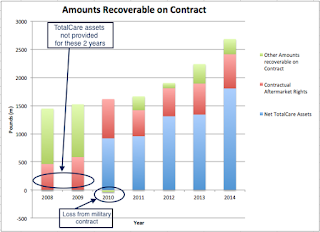Rickmers Marine
A REIT-like structure, holding and leasing 16 panamax container vessels (3400-5000 TEUs). Their fleet is new: all but one vessel was built in 2007 or later, and they have a 25-30 year lifespan.Rickmers stock price has plunged after it suspended dividends, due to lower revenue from declining rates. How much of this is already built into the share price?
First off, Rickmers has a loan covenant waiver that they need to extend, due end of this year. If they can't, all bets are off, and they'll have to sell vessels.
If they extend, then we value Rickmers by its ability to generate free cashflow and pay off debt. Or maybe just survive. Here's the relevant 3Q15 numbers for back-of-the-envelope calculations .
Income/Cashflows
- Revenue 27m
- Depreciation: 8.7m
- Vessel operating expenses: 9.6m
- Misc fees/expenses: 0.9m
- Finance expenses: 3.3m
Vessel operating expenses seem to be pretty constant: they vary by at most 10% over the past 8 quarters. Future revenue and finance expenses are the two big moving parts here.
Revenue has dropped as their fleet's long term contracts have expired. 11 vessels are now on short term contracts:
Three vessels we re-leased this quarter at around USD $6200, which is the market spot rate. This rate has dropped sharply recently, and is now at the GFC levels of 08/09:
So everything depends on the rate. In their 3Q conference all, Rickmers' management states that this rate is just above cash breakeven.
Container Shipping Outlook
Depends on demand and supply. I can't find any optimistic numbers on the container shipping market:
- Supply: Estimated new supply exceeds demolitions for the next few years:
- Demand: In our last report we discussed if a potential gap in the market was the reason for 6-12 months’ charter rates for ships sized 1,000-4,250 TEU to significantly increase over the first five months of 2015. Today we can see half of the gain is now gone, and the rise in time-charter rates seemed to be more of a short-term imbalance rather than a long-term improved market.
b) Maersk Broker (13 Nov 2015):
- In the 3,000-4,000 TEU segment...There is still more than sufficient supply of tonnage within this segment during the remainder of the year so we expect the rates to remain stable in the USD 6,000's depending on the exact vessel design.
c) Rickmer's 3Q conference call:
- More than 30 vessels are currently idle in Asia and ready to sail now.
Another trend is that new container ships are far larger (up to 20k TEUs), in a bid to drive economies of scale. Some of the 3000-4000 TEU ships are now being used as feeder vessels (including the Laranna Rickmers, leased to Simatech).
Debt
They have:
- 325m bank loans (USD Libor + 1.7%). 46.5m short term, 279m long term. With 50m cash to offset the short term loan due.
- SGD 100m (~USD 80M) "Series 1 Notes" issued May 2015 S100m: 8.45% PA, matures May 2017. Currency risk unhedged now.
A large chunk is due in 2017:
Their USD bank loans (in Q3 around 2+% interest) will have to be refinanced in 2017. I would expect interest rates to be higher in future, lets say 3 or 4 fed hikes. About 1% or so, giving a rate of 3+ percent (if they can refinance under the same conditions....the covenants).
But the loans come with restrictive covenants, and they may choose to refinance by their MTN program instead (of which only 100m out of 300m has been used). This has a high interest rate at 8+%, and there is also a refunding risk every 3 years. (I assume they would hedge currencies if they take on more SGD debt).
I calculate that, if the market rate stays at $6300/day, by the end of 2017, they need to refinance USD 135m plus SGD 100m. Assuming they use the MTN and get the similar rates, thats about USD 17m per year interest. Or 4.3m a quarter, an increase of 30% over 3Q15. Manageable.
Can they survive?
Probably. It all depends on the rates. If they plunge below cash breakeven by 2017, Rickmers may not be able to secure financing on favourable terms. Or on any terms at all? Either demand needs to recover, or ships need to be scrapped.
Historically, have container rates gone below cash breakeven for long periods before? Need to do more research.
As value investors, how would we play a cyclical industry? Wait for the industry to bleed for a while... my guess is - for long lived assets it will take years. Then buy companies with strong balance sheets and cashflows, if any. Easy to say, hard to do.
















































